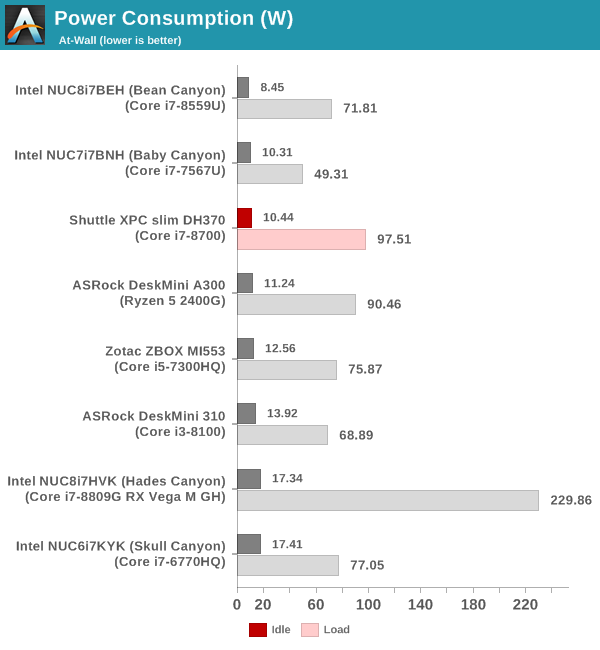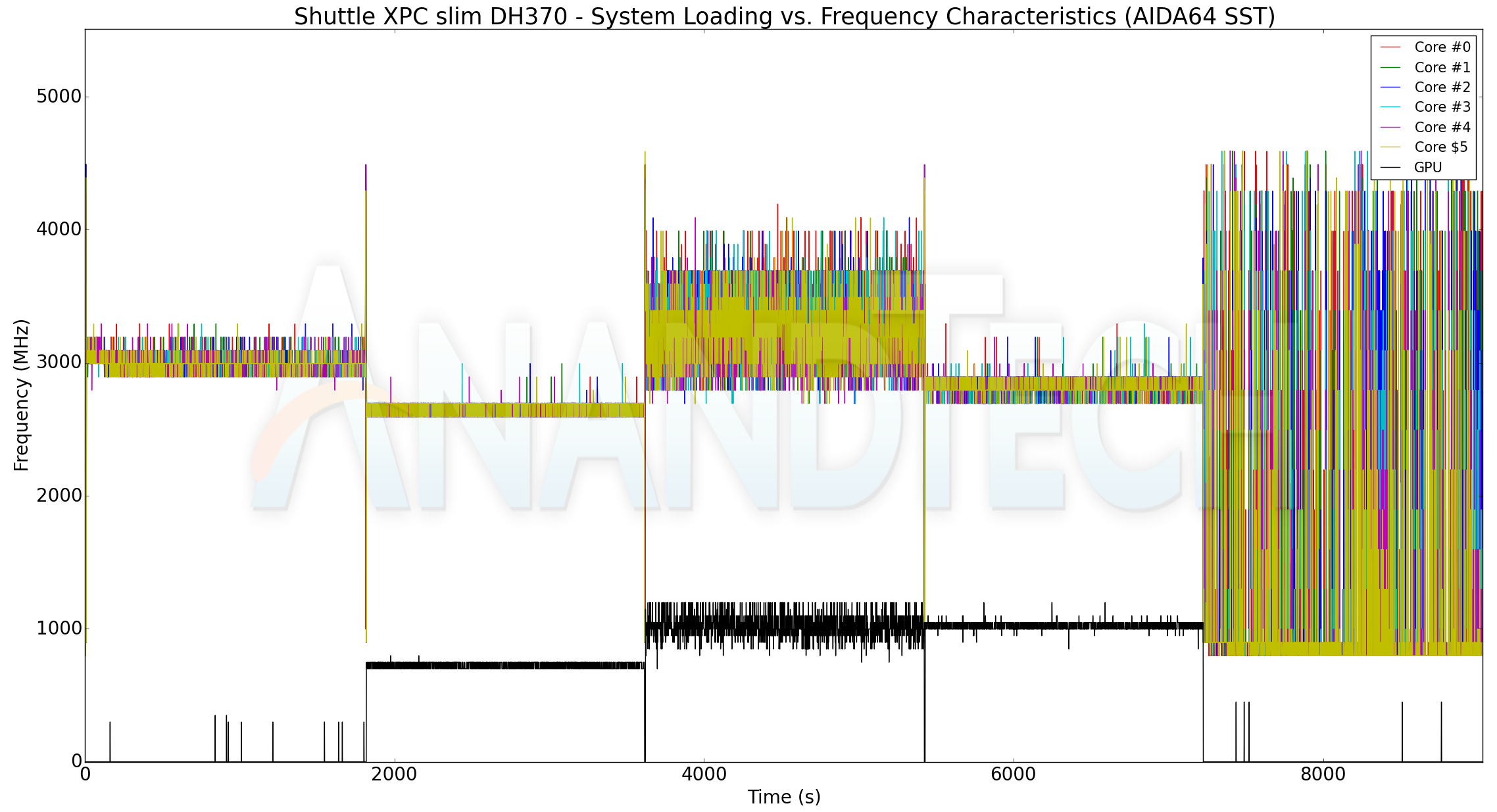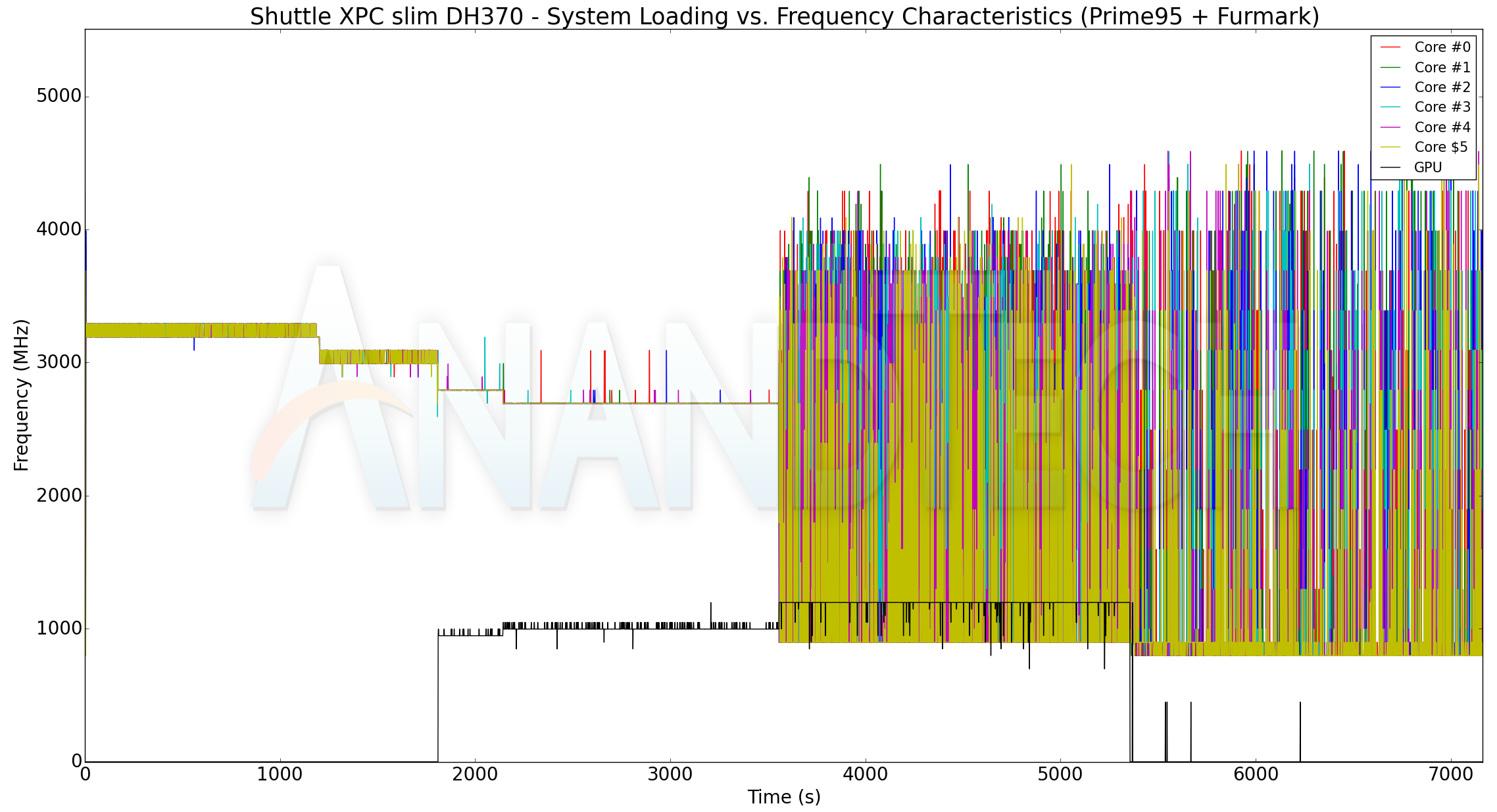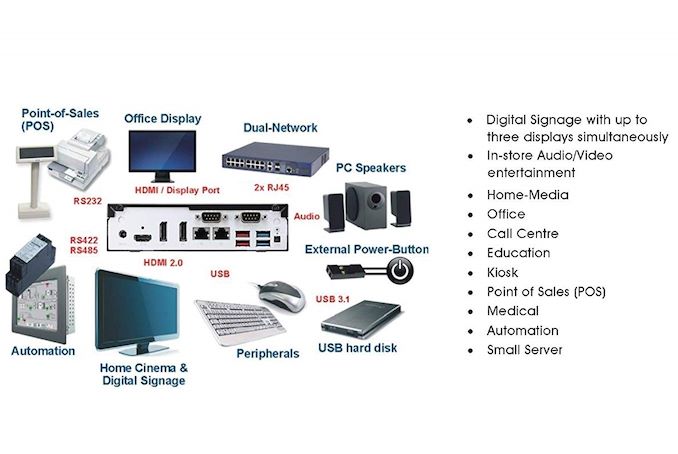Shuttle XPC slim DH370 mini-PC Review: A Compact Digital Signage Powerhouse
by Ganesh T S on May 6, 2019 8:00 AM ESTMiscellaneous Aspects
We have taken a detailed look at the performance of the Shuttle XPC slim DH370 and its suitability for different use-cases in its target markets. Prior to providing some concluding remarks, it is important to get an idea of the power consumption numbers for the system as well as the efficiency of its cooling solution.
Power Consumption
The power consumption at the wall was measured with a 4K display being driven through the HDMI port. In the graphs below, we compare the idle and load power of the Shuttle XPC slim DH370 with other low power PCs evaluated before. For load power consumption, we ran the AIDA64 System Stability Test with various stress components, as well as our custom Prime95 / Furmark loading scripts, and noted the maximum sustained power consumption at the wall.

The system's 10.44W idling power is praiseworthy, given the choice of components. Stressing the 65W TDP processor also makes the system sustain more than 97W at the wall. This is in contrast to the 69W stress number for the 65W TDP Core i3-8100 in the DeskMini 310. The design of the Shuttle XPC slim allows for taking full advantage of the capabilities of the installed processor.
Thermal Performance
Our thermal stress routine starts with the system at idle, followed by four stages of different system loading profiles using the AIDA64 System Stability Test (each of 30 minutes duration). In the first stage, we stress the CPU, caches and RAM. In the second stage, we add the GPU to the above list. In the third stage, we stress the GPU standalone. In the final stage, we stress all the system components (including the disks). Beyond this, we leave the unit idle in order to determine how quickly the various temperatures in the system can come back to normal idling range. The various clocks, temperatures and power consumption numbers for the system during the above routine are presented in the graphs below.
| Shuttle XPC slim DH370 System Loading with the AIDA64 System Stability Test | |||

Despite being rated for operation at 3.2 GHz, the cores spend a majority of their time around the 3 GHz mark in the course of the AIDA stress test. The GPU operates at up to 1.2 GHz. The temperatures always stay south of 85C. The power numbers are more interesting. When all components are getting stressed, the CPU package power is constant around 48W. The interesting aspect to note here is that there is not much variation in the package power for each workload component.
We also run a custom stress test involving Prime95 and Furmark. Starting with Prime95 alone, we add Furmark to the mix after 30 minutes. After another 30 minutes of simultaneous CPU and GPU loading, we terminate the Prime95 process alone and let the GPU run at full throttle. The metrics graphed for the AIDA64 system stability test are also graphed here.
| Shuttle XPC slim DH370 System Loading with Prime95 and Furmark | |||

Our custom test is much more stressful. We see the cores starting out at 3.2 GHz, but, Prime95 makes them reach 90C around 20 minutes into the test. Once the temperature goes above, we see the cores clock down to around 3 GHz. Despite the lower clocks, the package power actually rises from around 50W to 52W. The addition of Furmark to the mix brings down the package power to 45W, and running only Furmark results in a package power dissipation of around 40W. Obviously, the latter two cases are much easier to handle for the cooling solution and we see the temperatures dropping rapidly.
Concluding Remarks
The Shuttle XPC slim DH370 is a compact computing powerhouse. All our benchmark numbers point to that. Shuttle's choice of RAM and SSD for our review configuration actually hold back the numbers a bit. Upgrading the RAM kit (to, say, DDR4-2666) and the SSD (to, say, a PCIe 3.0 x4 NVMe one) would only serve to make the already chart-leading performance better. The choice of external high-speed I/O - in particular, making all four possible USB 3.1 Gen 2 ports come out, is laudable. Dual Intel NICs ought to make the DH370 a good fit for certain networking use-cases.
Shuttle targets various market segments, as shown in their product brief. The DH370 is a very good fit for all of them, but, with caveats. The system can indeed drive three different 4Kp60 displays with HDR simultaneously. However, end-users should note that the usage of this mode may result in performance loss for some of the system workloads. For in-store and home media playback and entertainment, the XPC slim DH370 ticks all the right boxes, but, the fan noise is a definite factor. It is possible that a T-series processor might not stress the cooling system as much. However, the configuration we evaluated was simply too noisy for use as a HTPC. The drawbacks we encountered are not much of a factor for the other targeted applications.
The Shuttle XPC slim DH370 deserves a lot of praise for incorporating a balanced set of features available in the Intel H370 platform into a compact system. The thermal solution (pictured above) does a lot of the heavy lifting to allow the installed processor to perform to its potential. However, its noise profile is also the one trade-off that consumers have to make for the compact size of the system. The $330 barebones price for the system is also reasonable considering the standalone prices for a good H370 motherboard, chassis, and PSU.
Shuttle does have scope for improving the DH370 further - for starters, we would have liked a couple of the USB 3.1 Gen 2 Type-A ports to be Type-C. A Thunderbolt 3 port would have also been nice to have, given that spare PCIe lanes from the PCH as well as the CPU are available. That said, Shuttle's unique features (such as the triple 4K display output) are quite difficult to achieve in a DIY build in this form factor. Based on the results of our evaluation, we recommend the Shuttle XPC slim DH370 for purchase after careful analysis of the expected use-cases.












37 Comments
View All Comments
mikato - Tuesday, May 7, 2019 - link
Don't get me wrong, I would like that too. SilentPCReview.com needs to be revived perhaps. They, and their community, were the best. People lost interest I guess once storage drives, power supplies, retail computers, even GPUs improved noise by a lot. Plus other reviewers started paying attention to noise partly through their work. But with mini PCs and HTPCs maybe there is renewed thirst for noise analysis.The issue may be - how does Ganesh prevent outside factors and just the changing ambient noise level from influencing noise measurements? He would need some type of anechoic chamber and probably some audio equipment. Read this to see what goes into it, for removing outside influence and actually having a low enough ambient noise level for meaningful measurements - http://www.silentpcreview.com/anechoic_chamber_SPC...
Then there are logistics issues. Will Anandtech pay for or provide what may be needed? Does he do review work at his house/apartment? Is there an Anandtech central office? Do other Anandtech reviewers mostly live in the same area? Can someone rent an anechoic chamber? Keep in mind SPCR was mostly one guy on a mission, while Anandtech and Ganesh have plenty of other concerns.
Is there a spot in the middle where noise measurements are "good enough"? Any ideas? I do see noise measurements at other review sites sometimes, but I don't know if they are good enough for comparing among different product reviews that took place at different times and possibly at different places.
GDVX_111 - Monday, June 13, 2022 - link
This query comes 3 years later, so I know that the odds on a response are not good, but WHICH existing Shuttle model is going to have more than adequate HTPC chops and features, as well as the desired quietness, heat dissipation, and reliability characteristics ? (Regardless of price, even.) I say existing model because I like Shuttle, and I don't care to build something from scratch out of disparate parts that may be available. The SH67H3 cube that still serves as my desktop computer would certainly fill the bill, and is plenty quiet even a few inches away on my desk, but of course it is several times the size and would require space I don't have in either of my video stacks.Another design factor that struck me as being perhaps dubious in these more compact, digital kiosk or signage oriented models has been the move to outboard power bricks, rather than an integrated PSU. But perhaps that is unavoidable, given the compact size.
bill44 - Monday, May 6, 2019 - link
How about 3D BD ISO playback?Does it use LSPCon for HDMI?
timecop1818 - Monday, May 6, 2019 - link
Yes, it uses MegaChips MCDP2850 to convert DisplayPort to HDMI 2.0. You can see it on the motherboard photo in the QuickStart manual. What about 3D BD ISO playback? Why wouldn't that work?ganeshts - Monday, May 6, 2019 - link
3D is usually not supported if you have a LSPcon. I have reason to believe 3D is not supported over the HDMI 2.0a ports in the last two Intel platform generations.With the advent of 4K and HDR, the industry has got much more convincing features to make people upgrade their equipment (compared to 3D). Effectively, 3D is dead from an industry viewpoint. YMMV.
Opencg - Monday, May 6, 2019 - link
great example of a tech killed off by lack of content (i mean good content). too many movies were simply reprocessed without being produced from the ground up with the intent of 3d. the industry tried to charge a premuim for lackluster content with hardware implementations having support and quality issues. not to mention some big problems like focal blur guessing.i really hope vr doesnt go the route of 3d games and 3d movies. but yeah people dont seem to understand that the most important things are affordability and minimizing barriers to entry. also not having an industry clinging to ancient monitization practices helps.
Death666Angel - Monday, May 6, 2019 - link
I think it is more about the technology itself. In order for stereoscopic 3D to work well, you need to have most of your field of vision filled by the content. That is easily done in a cinema, where the screen is huge and the ambient lights are darkened and everyone is fine with that. At home, most people I know have their setup with a small TV (37" to 50") and it is in a corner somewhere it makes sense but is out of the way (since the TV may be on a lot, but hardly watched focused most of the time). Only some die hard movie people (like myself) have a large TV (55"+, preferably 65"+) that is not too far away from the main sitting position (couch). But even then, it is a bit too small for 3D to work well and immerse myself in it and I can't really darken everything down as much as in the cinema. And I have never had comfortable 3D glasses. They always either hurt my sides or my nose.VR won't go away as 3D will, since it has a much larger impact in the professional world (engineering, architecture, medicine, art...), but home VR has an uphill battle to fight still.
0ldman79 - Tuesday, May 7, 2019 - link
Honestly I'm kind of expecting 3D to come back again.They are now making fully transparent TVs.
Layer the screens and you can have actual 3D (at least two layers of depth) without glasses.
Death666Angel - Tuesday, May 7, 2019 - link
How would that work? You still need a way to block one eye from seeing the content the other eye sees. Doing it with a parallax barrier requires cost and doesn't work for more than one person without a lot of complications (which increase price, a lot). You also lose resolution compared to full 3D SBS and active shutter glasses.Or do you just mean 3D in a diorama way where you have discreet layers of content? That is not 3D.
bill44 - Monday, May 6, 2019 - link
Thanks ganeshts.I know it's a dead format, but I would like to use it as long as my TV lasts.
Hoping one day I can get a modern PC that has native HDMI ports (no LSPCon).
Does anyone know of TB3->HDMI adapter/cable that does work?